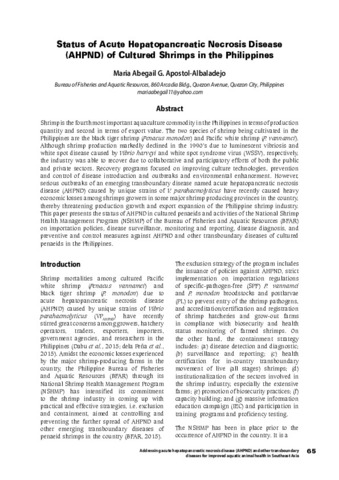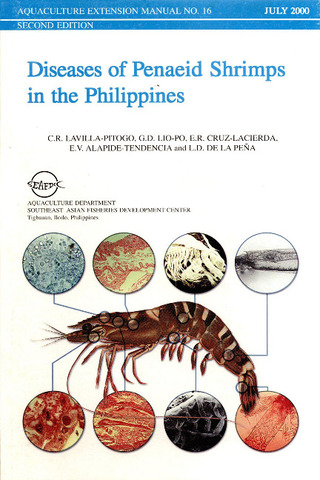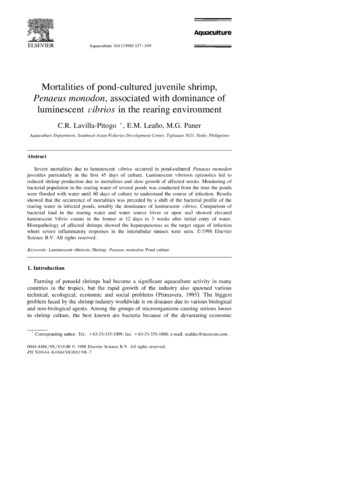Status of acute hepatopancreatic necrosis disease (AHPND) of cultured shrimps in the Philippines
- Global styles
- MLA
- Vancouver
- Elsevier - Harvard
- APA
- Help

วันที่
2016ผู้เขียน
Page views
9,820ASFA keyword
AGROVOC keyword
Taxonomic term
เมตาดาต้า
แสดงระเบียนรายการเต็ม
Share
นามธรรม
Shrimp is the fourth most important aquaculture commodity in the Philippines in terms of production quantity and second in terms of export value. The two species of shrimp being cultivated in the Philippines are the black tiger shrimp (Penaeus monodon) and Pacific white shrimp (P. vannamei). Although shrimp production markedly declined in the 1990 s due to luminescent vibriosis and white spot disease caused by Vibrio harveyi and white spot syndrome virus (WSSV), respectively, the industry was able to recover due to collaborative and participatory efforts of both the public and private sectors. Recovery programs focused on improving culture technologies, prevention and control of disease introduction and outbreaks and environmental enhancement. However, serious outbreaks of an emerging transboundary disease named acute hepatopancreatic necrosis disease (AHPND) caused by unique strains of V. parahaemolyticus have recently caused heavy economic losses among shrimps growers in some major shrimp producing provinces in the country, thereby threatening production growth and export expansion of the Philippine shrimp industry. This paper presents the status of AHPND in cultured penaeids and activities of the National Shrimp Health Management Program (NSHMP) of the Bureau of Fisheries and Aquatic Resources (BFAR) on importation policies, disease surveillance, monitoring and reporting, disease diagnosis, and preventive and control measures against AHPND and other transboundary diseases of cultured penaeids in the Philippines.
การอ้างอิง
Apostol-Albaladejo, M. A. G. (2016). Status of acute hepatopancreatic necrosis disease (AHPND) of cultured shrimps in the Philippines. In R. V. Pakingking Jr., E. G. T. de Jesus-Ayson, & B. O. Acosta (Eds.), Addressing Acute Hepatopancreatic Necrosis Disease (AHPND) and Other Transboundary Diseases for Improved Aquatic Animal Health in Southeast Asia: Proceedings of the ASEAN Regional Technical Consultation on EMS/AHPND and Other Transboundary Diseases for Improved Aquatic Animal Health in Southeast Asia, 22-24 February 2016, Makati City, Philippines (pp. 65-72). Tigbauan, Iloilo, Philippines: Aquaculture Department, Southeast Asian Fisheries Development Center.
Type
Conference paperISBN
9789719931065
Related items
Showing items related by title, author, creator and subject.
-
Series: Aquaculture extension manual; No. 16
Diseases of penaeid shrimps in the Philippines
Lavilla-Pitogo, Celia R.; Lio-Po, Gilda D.; Cruz-Lacierda, Erlinda R.; Tendencia, Eleonor ; de la Peña, Leobert D. (Aquaculture Department, Southeast Asian Fisheries Development Center, 2000)
The manual provides information on the diseases that affect the 3 major species of shrimps cultured in the Philippines: Penaeus monodon, P. merguiensis and P. indicus. It includes the common name of the disease, causative ...
; de la Peña, Leobert D. (Aquaculture Department, Southeast Asian Fisheries Development Center, 2000)
The manual provides information on the diseases that affect the 3 major species of shrimps cultured in the Philippines: Penaeus monodon, P. merguiensis and P. indicus. It includes the common name of the disease, causative ... -
Current status of shrimp farming and diseases in Cambodia
Lang, Ouch; Sothea, Mey (Aquaculture Department, Southeast Asian Fisheries Development Center, 2016)The farming of penaeid shrimps in Cambodia began in 1989 and has significantly expanded since 1991. Shrimp cultivation has been carried out in the four coastal provinces, i.e. Kampot, Kep, Preah Sihanouk Ville, and Koh ... -
Mortalities of pond-cultured juvenile shrimp, Penaeus monodon, associated with dominance of luminescent vibrios in the rearing environment
Lavilla-Pitogo, Celia R.; Leaño, Eduardo M.; Paner, Milagros G. (Elsevier, 1998)Severe mortalities due to luminescent vibrios occurred in pond-cultured Penaeus monodon juveniles particularly in the first 45 days of culture. Luminescent vibriosis epizootics led to reduced shrimp production due to ...






